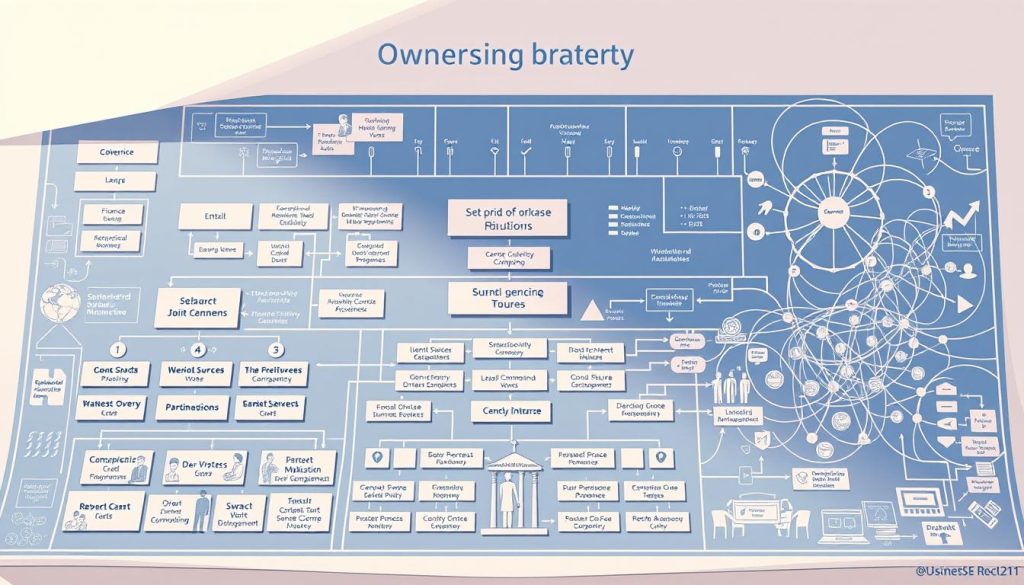What if your professional collaboration unravels over unspoken expectations? Many entrepreneurs assume trust alone can sustain a business relationship, but nearly 65% of disputes arise from undocumented agreements. A formal framework isn’t just paperwork—it’s your first line of defense.
Every successful venture thrives on clarity. A well-structured business document defines roles, profit splits, and decision-making processes from the start. Without it, default state laws dictate outcomes—often misaligned with your vision.
Consider this: French professionals face unique challenges under local commercial codes. Customized terms ensure your interests remain protected, whether resolving conflicts or planning exit strategies. This isn’t about pessimism—it’s about smart preparation.
Table of Contents
Key Takeaways
- Formal agreements prevent misunderstandings by outlining roles and responsibilities
- Default state laws may override verbal arrangements in legal disputes
- Clear profit-sharing terms maintain fairness as businesses grow
- Custom clauses address industry-specific risks and regional regulations
- Exit strategies protect all parties during unexpected changes
Understanding Partnership Agreements
Strong business relationships start with clear guidelines. Formal contracts create structure where assumptions fail, especially when financial stakes grow. These documents act as navigational tools for collaborative ventures.
Definition and Core Value
A business collaboration contract serves three critical purposes. It outlines roles, prevents misunderstandings, and establishes financial protocols. Without it, state laws automatically fill gaps—often mismatched with your company’s needs.
Consider this scenario: two founders split profits verbally. When revenue triples, unequal contributions create friction. Courts typically reference the Revised Uniform Partnership Act (RUPA) in such cases—a default framework used across 44 U.S. states.
How Legal Systems Intervene
Modern commercial codes evolve to address new challenges. The 1917 Uniform Partnership Act has undergone multiple revisions, reflecting changing business practices. These updates ensure fairness when contract terms lack specificity.
| Key Aspect | UPA | RUPA |
|---|---|---|
| Liability Allocation | Equal responsibility | Role-based shares |
| Dispute Resolution | State guidelines | Custom procedures |
| Profit Distribution | 50/50 split default | Contribution-based |
This table shows why tailored terms matter. Generic laws might force equal liability splits, even if one party invested more capital. Detailed contracts override these defaults, protecting all involved parties.
Key Elements of a Strong Partnership Agreement

Successful collaborations thrive on precise frameworks. A robust business document acts as both compass and shield, aligning expectations while safeguarding interests. Let’s explore the non-negotiable components that keep ventures stable through growth and challenges.
Ownership, Contributions, and Profit Sharing
Clarity begins with quantifying value. Document every investment—cash, equipment, or expertise—to determine equity stakes. A partner contributing 70% of startup capital typically holds matching ownership rights. This transparency prevents disputes when scaling operations.
Profit allocation formulas should mirror these percentages. For example:
- Financial inputs (cash/assets)
- Intellectual property rights
- Operational responsibilities
Update these terms annually as roles evolve. A tech founder’s initial codebase might warrant 60% equity, but later investors could dilute shares proportionally.
Defining Roles and Responsibilities
Ambiguity in management roles sinks ventures faster than financial issues. Assign specific domains like budgeting, client relations, or product development. Detail who approves contracts or hires staff—these boundaries prevent overlapping authority.
Include escalation protocols for deadlocked decisions. Some teams use third-party mediators or predefined voting thresholds. One French marketing firm requires 75% partner approval for expenditures exceeding €50,000.
Exit clauses remain critical. Specify valuation methods for buyouts and succession plans for unexpected departures. This preparation transforms potential crises into manageable transitions.
Drafting Your Partnership Agreement: A Step-by-Step Guide

Building a collaborative venture demands careful planning. Transparent dialogue forms the bedrock of sustainable business relationships. Start by mapping core objectives and potential challenges before drafting any legal text.
Initial Discussions and Planning
Begin with open conversations about financial contributions and operational roles. Discuss how profits will support growth versus personal compensation. Align expectations about work hours and long-term exit scenarios.
For 50/50 ventures, define decision-making protocols upfront. One French tech startup uses a rotating lead system for major choices. Document these understandings immediately—even in bullet-point form—to create a reference point.
Consulting Legal and Tax Experts
Professional guidance transforms rough ideas into enforceable terms. Attorneys identify gaps in liability coverage while tax specialists optimize profit distribution structures. Consider this comparison:
| Approach | DIY Drafting | Expert-Assisted |
|---|---|---|
| Compliance | 65% meet basic standards | 98% full compliance |
| Dispute Prevention | 40% effectiveness | 89% effectiveness |
| Tax Efficiency | Limited optimization | Custom strategies |
Investing in specialized advice during drafting prevents costly revisions later. Many French professionals combine notaire consultations with accountant reviews for comprehensive protection.
Remember: A well-structured document evolves with your venture. Schedule annual reviews to address new challenges and opportunities as you grow.
Exploring Different Partnership Structures
Choosing the right framework for your venture determines both operational flexibility and financial security. Business structures vary in risk exposure and management requirements, making informed selection critical for long-term stability.
General Partnerships
This default option works for collaborators seeking simplicity. All participants share equal liability for debts and legal actions. Personal assets remain vulnerable if the company faces financial trouble—a key consideration for new ventures.
Limited and Limited Liability Models
Complex ventures often benefit from layered structures:
- Limited partnerships separate operational roles. Active managers shoulder full responsibility, while investors contribute funds without daily involvement
- Limited liability partnerships shield professionals from colleagues’ errors. Ideal for law firms or medical practices, though unavailable in 12 U.S. states
- LLLPs (limited liability limited partnerships) combine protections for all participants. Popular in French real estate ventures despite varying regional recognition
| Structure | Liability | Best For |
|---|---|---|
| General | Full | Small teams |
| Limited | Mixed | Investor-heavy projects |
| LLP | Partial | Professional services |
| LLLP | Protected | Asset management |
Industry-Specific Solutions
Tech startups often use equity-based models, while creative agencies prefer profit-sharing frameworks. Regulatory requirements differ too—French accounting firms must maintain specific licenses for LLP status.
« Your structure should grow with your ambitions, » advises Marseille-based attorney Léa Dubois. « Annual reviews ensure alignment with evolving risks and opportunities. »
Managing Partnership Decisions and Dispute Resolution
Clear governance structures transform potential conflicts into growth opportunities. When multiple stakeholders drive a venture, predefined protocols maintain momentum during challenges. Structured approaches prevent costly delays while preserving professional relationships.
Setting Decision-Making Guidelines
Define authority levels early using tiered approval systems. Daily operational choices might require single-partner sign-off, while strategic shifts demand group consensus. A Paris-based logistics firm uses this framework:
| Decision Type | Approval Required | Timeline |
|---|---|---|
| Vendor Contracts | Single authorized partner | 48 hours |
| Staff Hiring | Majority vote | 7 days |
| Business Expansion | Unanimous consent | 30 days |
Binding authority limits prevent unauthorized commitments. Specify which roles can sign loans or lease agreements. Regular audits ensure compliance with these protocols.
Establishing a Dispute Resolution Process
Effective conflict management begins with mediation clauses. Require neutral third-party involvement before pursuing litigation. Many French ventures use industry associations for affordable arbitration services.
Implement escalation timelines for different disagreement levels:
- Operational disputes: 14-day negotiation window
- Strategic conflicts: 30-day mediation period
- Fundamental issues: Binding arbitration within 60 days
Document all resolution steps to create precedents for future challenges. This structured approach reduces emotional tension while protecting business continuity.
Effective partnership agreements for Business Protection
Imagine facing a major business decision without alignment from your collaborators. Structured contracts act as safety nets, transforming uncertainty into actionable protocols. They preserve professional relationships while safeguarding assets during unexpected challenges.
Well-designed frameworks prevent costly misunderstandings. Clear dissolution terms ensure orderly transitions if collaborators part ways. French commercial courts frequently reference these documents when resolving disputes over asset division or client retention.
Your financial security depends on precise liability definitions. Contracts limit personal exposure by separating business debts from private assets. One Lyon-based consulting firm avoided bankruptcy by specifying capital contribution limits in their initial agreement.
Three critical protections every contract should include:
- Succession plans for sudden departures
- Non-compete clauses to protect market position
- Disability provisions ensuring operational continuity
« A contract isn’t about distrust—it’s about mutual respect, » notes Paris legal expert Émilie Rousseau. Her team reviews 150+ agreements annually, often adding emergency decision protocols missing from standard templates.
Regular updates keep terms relevant as businesses evolve. Schedule bi-annual reviews to address new risks like cybersecurity threats or international expansion. Proactive adjustments maintain alignment with France’s evolving commercial codes.
Your professional reputation deserves structured defense. Comprehensive agreements create enforceable standards while fostering trust through transparency. They transform potential crises into manageable transitions, preserving both relationships and revenue streams.
Navigating Financial Responsibilities and Liabilities
What safeguards your venture when financial tides shift? Clear financial frameworks protect both professional relationships and personal assets. Unlike corporations, partnerships don’t shield members from business debts—a critical detail under French commercial law.
Capital Contributions and Equity Distribution
Initial investments set the foundation, but ongoing contributions matter more as companies grow. Outline cash injections, equipment values, and sweat equity percentages. A French tech startup might allocate 30% equity to a partner providing proprietary software.
Update funding protocols annually. Specify triggers for additional capital calls, like expansion plans or emergency reserves. This prevents disputes when unexpected costs arise.
Handling Liabilities and Profit Loss Sharing
Every company faces risks—your agreement determines who bears them. Partners remain personally liable for debts unless structured otherwise. Consider these protections:
Profit splits should reflect contributions, not just ownership percentages. A sales-driven partner might receive 15% extra profit share for exceeding targets. Document tax implications for each distribution method.
Loss allocation requires equal attention. Some teams use capital accounts to track deficits, while others limit liability through insurance policies. One Lyon bakery avoided personal bankruptcy by converting to an LLC during market downturns.
Regularly review financial terms with legal experts. Adapt clauses to address new regulations or operational shifts, ensuring your safeguards evolve with your ambitions.
FAQ
Why are formal agreements critical for business collaborations?
Formal agreements clarify expectations, protect financial interests, and minimize risks. They establish legally binding terms for decision-making, profit distribution, and conflict management, ensuring all parties operate with shared goals.
What core elements should every partnership contract include?
Essential components include capital contributions, profit/loss allocation, management roles, exit strategies, and dispute resolution processes. Industry-specific clauses like non-compete terms or intellectual property rights may also apply.
How do limited liability structures differ from general partnerships?
Limited liability partnerships (LLPs) shield members from personal debt obligations, unlike general partnerships where all partners share unlimited liability. LLPs also allow flexible management roles while maintaining tax advantages.
When should businesses consult legal experts during agreement drafting?
Engage professionals during initial planning stages to align contracts with state laws like the Uniform Partnership Act. Experts ensure compliance, optimize tax implications, and address liability scenarios unique to your industry.
How can collaborators resolve disputes without court intervention?
Contracts should outline mediation procedures, arbitration terms, or buyout options. Many teams use tiered resolution systems—starting with internal negotiations before escalating to third-party facilitators.
What safeguards prevent financial imbalances in profit-sharing models?
Clearly define equity percentages based on capital investments, labor contributions, or intellectual property value. Regular audits and adjustment clauses help maintain fairness as business needs evolve.





